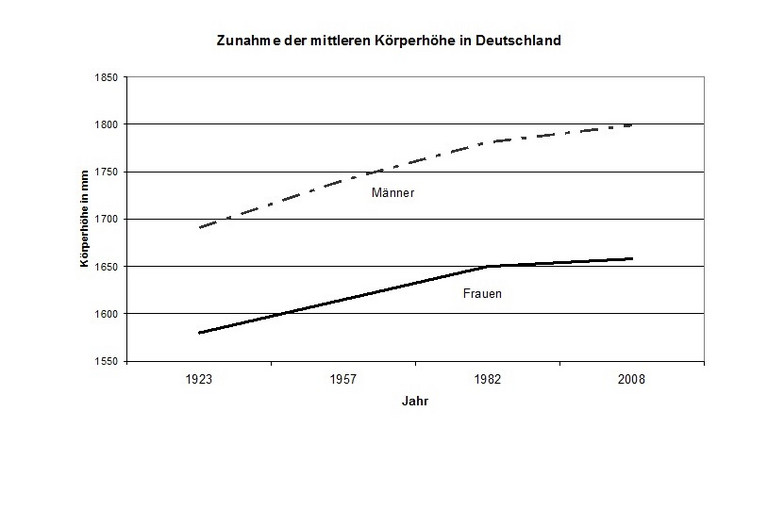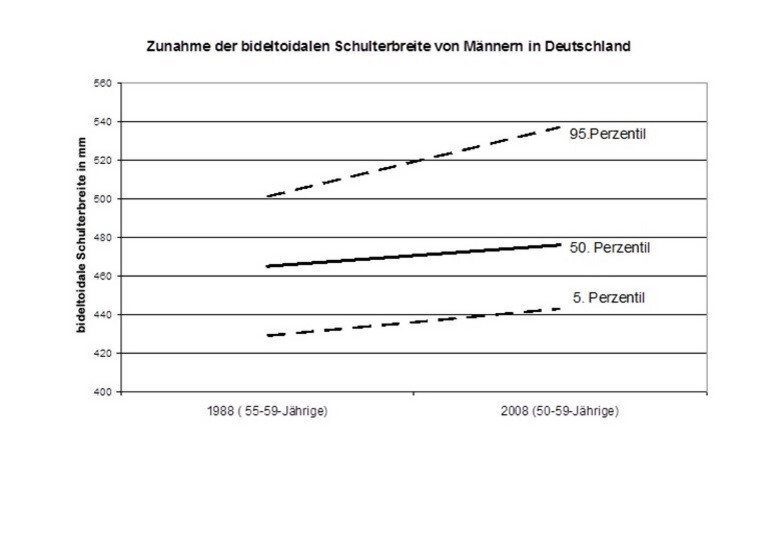Values for body dimensions and their distributions change over the course of time. Recent anthropometric data should therefore be used. Should recent data not be available, older data should be used in consideration of the current trends. If limitations are required, for example for ranges of adjustment, they should be defined respectively for length, breadth and circumferential measurements for the lower percentiles; conversely, possible allowances should be added for the upper percentiles.
Body dimensions change from one generation to the next. This phenomenon, termed the secular trend or secular acceleration, is generally explained by improvements in the environmental conditions influencing growth during childhood. Factors include improvements to the quality of nutrition and to the health situation of children and young people. Other factors are also discussed.
The generational increase in body height of approximately 11 mm for men and 9 mm for women per decade over the last 150 years is essentially attributable to increased growth of the long bones of the legs. The long bones in the arms, hands and feet are also longer now than in earlier generations. This leads to changes in the body proportions, particularly in the ratio of the legs to the trunk, but also in other regions of the body. Today's young adults are on average taller than their peers in the past, and are also taller than today's middle-aged and older adults. They also have longer legs, and are therefore not only taller than older people, but also have a greater tendency to be "seated dwarfs".
In the industrial economies, this increase in the length dimensions attributable to acceleration is currently slowing (see image below). The development conditions influencing growth and thus also the body dimensions are ideal; the maximum body height that is genetically possible is therefore increasingly being reached.

By contrast, the increase in the circumferential dimensions (e.g. waist girth, hip girth, abdominal girth) and the breadth dimensions determined by soft tissue (e.g. bideltoid/maximum shoulder breadth, body breadth sitting) continues unabated (see image below). This trend is caused by the imbalance between nutritional energy intake and lack of exercise.
For the majority of ergonomic applications, changes become relevant only when they exceed around 1 cm. The body dimensions for which a time limit should be applied to the continued use of historical data are dependent essentially upon the rate of the changes described above. As a rule of thumb, length-related body dimensions over 25 years old should not be used. In consideration of the changes currently being observed in breadth and circumferential dimensions, data for these dimensions even more recent than this may already be obsolete. For safety-related applications, even smaller changes must be considered by inclusion of the most up-to-date data possible (refer to the example of the KAN expert report on the test finger).

Since the change in body dimensions is on the one hand strongly dependent upon changes in environmental conditions and thus also human behaviour (exercise, healthy eating, etc.) and on the other, at least where circumferential dimensions are concerned, may also be reversible, extrapolation is not possible. As explained comprehensively in DIN SPEC 33402-5 (governing ergonomics/human body dimensions/study of methods for extrapolation and estimation of anthropometric data), future environmental conditions cannot be predicted, and consequently nor can their influence upon body dimensions. Any extrapolation of anthropometric data therefore remains a relatively uncertain estimate.